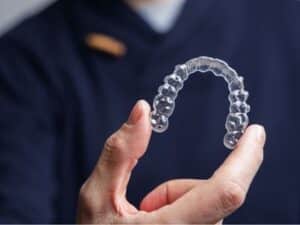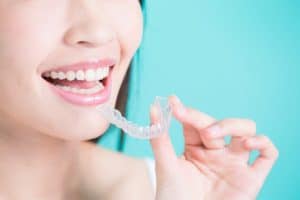The average age to get Invisalign doesn’t exist. Teens often have Invisalign from 11 to 15, and many adults may have treatment between 18 and 25 during their college years. Invisalign is available to patients as young as 6 and 7, although they may need parental assistance. There is also no age that is too old for Invisalign. As long as a person has good oral health and most of their natural teeth, Invisalign can correct alignment problems.. And it is offered by providers in various locations, including Invisalign Allentown, PA.
What is Invisalign® Treatment?
Invisalign treatment is a system of clear tray aligners that gradually shift teeth into alignment. The system was only good for correcting minor alignment issues at first. Since then, Align Technology has continued to develop the system to broaden the scope of use.
After 23 years in use, Invisalign is one of the most sought-after orthodontic treatments for patients of all ages. The tray aligners can correct minor to complex malocclusions with a record of success. So far, more than 12 million smiles have been transformed using Invisalign, including more than 3 million teens.
Align Technology has added SmartTrack® material and SmartForce® attachments and continues to lead the field in digital technology. Their ClinCheck® software allows doctors to develop treatment plans accurately using 3D modeling from intraoral scanners.
How Does Invisalign Work?
Traditional braces work using tension to create a force to move teeth. The archwire is attached to each bracket, and as the doctor tightens the wire, it creates tension. This method has been very effective for centuries and has seen many improvements. However, when Invisalign hit the orthodontics scene, attitudes changed somewhat.
Invisalign also uses physics, but rather than tension, it uses gentle pressure to create the force that moves teeth into alignment. Each custom-fit tray is molded to fit over your teeth. Trays come in sequential sets, and you’ll wear each set for about two weeks. As you progress through the tray sets, they gently push your teeth into alignment. Trays need to be in place for 20 to 22 hours every day, but you can remove them for oral hygiene, drinking, and eating.
Conditions That Invisalign Can Treat
In most cases, Invisalign is an effective treatment for minor to complex alignment issues. Some conditions may require additional orthodontic measures, such as orthognathic surgery. Your orthodontist will tell you if other procedures are necessary during your initial consultation. If you have one of the following problems, Invisalign can help:
- Crossbite
- Open bite
- Underbite
- Overbite
- Crowded teeth
- Gap teeth (diastema)
If your oral health is good, you may be a great candidate for Invisalign treatment.
Invisalign vs. Braces — Which is Better?
In a direct comparison, both treatment methods match up pretty solidly. Braces have been around longer, but Invisalign does a formidable track record. Both can treat many different orthodontic conditions. Traditional braces may offer slightly more versatility for some issues. On a cost comparison, they are pretty close, although braces are usually somewhat less costly. Treatment duration is about the same for both also.
When you have an examination, the doctor will recommend the treatment they feel will work best for your teeth. Every smile is different, so there will never be a one-size-fits-all solution.
Invisalign Cost — Is It Worth It?
The national average cost for Invisalign ranges from $3,000 to $5,000. Your costs may be higher or lower, depending on a variety of factors, including:
- Degree of misalignment
- Location of treatment
- Whether you have dental insurance
- Your overall oral health
Traditional braces may average between $2,000 and $6,000 as a comparison. As you can see, the two treatments are very comparable in cost, with braces being slightly lower for some patients.
Special Considerations for Younger Patients
Younger patients can now use Invisalign treatment rather than having traditional braces. Although the treatment can be very effective, there are a few things that parents should consider before opting for this treatment for a child or teen.
Children should see an orthodontist by their seventh birthday. That does not mean that they will need braces or other interventions. The early check-up aims to catch potential problems before they become more significant problems. Children have lost most of their deciduous (baby) teeth at that age, and most of their adult teeth have erupted or are poised to erupt. An orthodontist can predict how the adult teeth will come in using X-rays and digital imaging. They will ensure that the jaw has enough room to promote good growth. Early treatment often makes secondary, Phase 2 treatment much easier.
Invisalign makes two products specifically with younger patients in mind. While identical to adult Invisalign, Invisalign First and Invisalign Teen are geared to smaller patients. Each has the same great features and capabilities.
Invisalign First
Invisalign First was created for Phase 1 orthodontic treatment, also called Early Treatment. This treatment will be recommended for children between 7 and 10 years old when necessary. Early treatment can use the typical growth patterns in young patients with potential orthodontic developments to make early corrections. Sometimes that may include orthodontic appliances such as palatal expanders and braces. When only minor early intervention is necessary, Invisalign First may be prescribed in some cases.
This unique system typically requires some parental supervision. Because the trays are removable and our children spend time at school away from us, Align Technology developed the Blue Dot monitoring system. This optional system adds a tiny blue dot to each alignment tray. The dot fades as your child wears the trays correctly. If the dot isn’t fading, your child isn’t wearing their trays enough. Simple and effective.
Invisalign Teen
Invisalign Teen is perfect for active teenagers and teens. The average age to get Invisalign is between 11 and 15. The trays can be removed for that pizza with their friends after school or for yearbook photos. Students can wear the trays during athletics but they are not a replacement for a protective mouthguard. If your teen participates in a contact sport requiring a mouth guard, they need one designed for that purpose. Providers in various locations, including Mouth Guard Allentown, PA, can assist with fitting a suitable mouthguard for sports.
Teens tend to be more responsible, but if you need to monitor your teen’s treatment, you may request the optional Blue Dot monitoring for their trays.
Is There an Average Age to Get Invisalign?
As you can see, there is no average age to get Invisalign. Patients can range in age from seven to 70 (or older). Most people get orthodontic care between 11 and 15 for teens and 18 and 25 for adults. But don’t let that limit you. You are never too old for Invisalign.
Call to Schedule Your Initial Consultation
If you are ready to explore the advantages of Invisalign for yourself or a child or teen, contact us at Dr. Bob Bryan Orthodontics.







